Abstract
A method by which virus penetration through condoms can be tested with simple, inexpensive equipment is described. The method uses chi X174 bacteriophage as the challenge virus and physiologically relevant pressure. Penetration by 0.1 microliters (or less) of challenge suspension can be readily detected. As examples, latex and natural-membrane condoms were examined.
Full text
PDF


Selected References
These references are in PubMed. This may not be the complete list of references from this article.
- Beytout D., Chambon M., Laveran H., De Champs C., Peigue-Lafeuille H., Socquet D. Une méthode simple et rapide de contrôle de l'imperméabilité aux virus des préservatifs. Presse Med. 1989 Oct 14;18(33):1651–1653. [PubMed] [Google Scholar]
- Carey R. F., Herman W. A., Retta S. M., Rinaldi J. E., Herman B. A., Athey T. W. Effectiveness of latex condoms as a barrier to human immunodeficiency virus-sized particles under conditions of simulated use. Sex Transm Dis. 1992 Jul-Aug;19(4):230–234. doi: 10.1097/00007435-199207000-00009. [DOI] [PubMed] [Google Scholar]
- Conant M. A., Spicer D. W., Smith C. D. Herpes simplex virus transmission: condom studies. Sex Transm Dis. 1984 Apr-Jun;11(2):94–95. doi: 10.1097/00007435-198404000-00009. [DOI] [PubMed] [Google Scholar]
- Conant M., Hardy D., Sernatinger J., Spicer D., Levy J. A. Condoms prevent transmission of AIDS-associated retrovirus. JAMA. 1986 Apr 4;255(13):1706–1706. [PubMed] [Google Scholar]
- Katznelson S., Drew W. L., Mintz L. Efficacy of the condom as a barrier to the transmission of cytomegalovirus. J Infect Dis. 1984 Jul;150(1):155–157. doi: 10.1093/infdis/150.1.155. [DOI] [PubMed] [Google Scholar]
- Lytle C. D., Budacz A. P., Keville E., Miller S. A., Prodouz K. N. Differential inactivation of surrogate viruses with merocyanine 540. Photochem Photobiol. 1991 Sep;54(3):489–493. doi: 10.1111/j.1751-1097.1991.tb02047.x. [DOI] [PubMed] [Google Scholar]
- Lytle C. D., Carney P. G., Vohra S., Cyr W. H., Bockstahler L. E. Virus leakage through natural membrane condoms. Sex Transm Dis. 1990 Apr-Jun;17(2):58–62. doi: 10.1097/00007435-199004000-00002. [DOI] [PubMed] [Google Scholar]
- Lytle C. D., Truscott W., Budacz A. P., Venegas L., Routson L. B., Cyr W. H. Important factors for testing barrier materials with surrogate viruses. Appl Environ Microbiol. 1991 Sep;57(9):2549–2554. doi: 10.1128/aem.57.9.2549-2554.1991. [DOI] [PMC free article] [PubMed] [Google Scholar]
- Minuk G. Y., Bohme C. E., Bowen T. J., Hoar D. I., Cassol S., Gill M. J., Clarke H. C. Efficacy of commercial condoms in the prevention of hepatitis B virus infection. Gastroenterology. 1987 Oct;93(4):710–714. doi: 10.1016/0016-5085(87)90431-8. [DOI] [PubMed] [Google Scholar]
- Retta S. M., Herman W. A., Rinaldi J. E., Carey R. F., Herman B. A., Athey T. W. Test method for evaluating the permeability of intact prophylactics to viral-size microspheres under simulated physiologic conditions. Sex Transm Dis. 1991 Apr-Jun;18(2):111–118. doi: 10.1097/00007435-199118020-00011. [DOI] [PubMed] [Google Scholar]
- Rietmeijer C. A., Krebs J. W., Feorino P. M., Judson F. N. Condoms as physical and chemical barriers against human immunodeficiency virus. JAMA. 1988 Mar 25;259(12):1851–1853. [PubMed] [Google Scholar]
- Van de Perre P., Jacobs D., Sprecher-Goldberger S. The latex condom, an efficient barrier against sexual transmission of AIDS-related viruses. AIDS. 1987 May;1(1):49–52. [PubMed] [Google Scholar]
- Voeller B., Coulter S. L., Mayhan K. G. Gas, dye, and viral transport through polyurethane condoms. JAMA. 1991 Dec 4;266(21):2986–2987. doi: 10.1001/jama.1991.03470210054028. [DOI] [PubMed] [Google Scholar]


